
ACCESS TO CASH MUST BE PRESERVED IN THE CONSTITUTION
Austrians are fearful of living without cash in their pocket. Cash to transact daily purchases. Cash to ensure anonymity in those transactions. They understand that physical cash, issued by the government’s Treasury department is essential to freedom. It is the Peoples money, non interest bearing and not created by a bank in a bank loan, thus not interest bearing.
Two weeks ago, the Chancellor of Austria, Karl Nehammer. said “More and more people are worried that cash could be restricted as a means of payment in Austria.” He went on to say “In Austria alone, €47 billion (nearly $52 billion) is withdrawn from ATMs every year and, on average, every Austrian carries €102 in cash.”
He also pointed out that, in Austria, 67% of payments under €20 (about US $22) are made with cash.
He has proposed that the country must enshrine the use of cash in its national Constitution, otherwise citizens may lose the right to use paper money and coins.
Nehammer also said “Cash is elementary as a means of payment. It is important that we create an unambiguous legal framework in order to secure it.”
He appointed Finance Minister Magnus Brunner to work on implementing the plan. Additionally, a roundtable assembling relevant ministries, industry representatives and the national bank will be held in September to determine the best way to make it happen.
European states, including Austria and Germany in particular, remain suspicious of using credit and debit cards and are still using cash much more than other nations, particularly for smaller, everyday items.
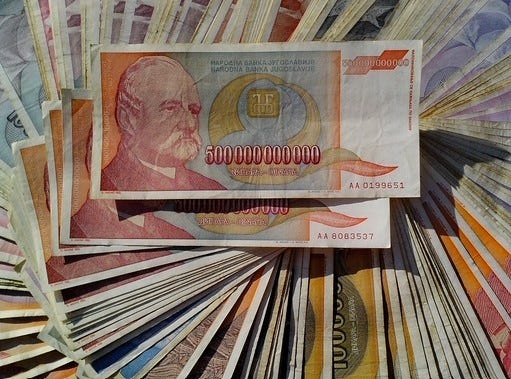
SIX CURRENCIES IN 100 YEARS
Germans can remember that they have had 6 different currencies in the last 100 years. The Euro is just the latest one. They know that political upheaval can occur rapidly and that change is ever present. And they are conscious that the Euro has many shortcomings, essentially putting the individual nations in the Euro Zone into monetary straight jackets. A currency union can severely limit the independence of a nation and lock it into an economic prison where one of the most critical tools of economic management is lost to a faceless, unelected committee of bureaucrats in a far off city.
If any nation gives up on physical cash, then they are heading down the road of totalitarian tyranny and economic crisis. If any nation agrees to join a monetary union (such as the Euro), then they are surrendering their independence to a group of policy makers who, in most cases, will be “appointed” and not elected. That is not democracy. That is the opposite of democracy. The potential for disenchantment with central decisions in one or two dominant nations is always a risk.
Cash produced locally in volume by an elected government is responsive to democratic principles. The elected politicians are then responsible for a key element of monetary policy. And the people can increase or decrease their demand for cash in response to economic developments in the real economy. That provides an important buffer to credit money that is created only by the (unelected) commercial banking system when bank loans are issued to willing borrowers. That buffer is lost if Cash is unavailable. Such a situation would leave the bankers in total control of the entire origination of national currency. The people (and their government) would then be effectively enslaved to the bankers.
WATCH THE NATIVES FIGHT BACK AGAINST TYRANNY IN THE UK
The UK is rapidly descending into a dystopia with card payments only in some stores where cash is not accepted. However, the natives are not happy about this. They are restless and fighting back. A struggle is becoming manifest.
Watch this short video – it explains the importance of cash to freedom. The location is an Aldi store in Greenwich, London.
“KEEP CASH, KEEP CASH, KEEP CASH — RESIST, DEFY, DO NOT COMPLY”
MAERSK SINKING? OR NOT?
The world’s largest owner of container ships is a company called A.P. Moller-Maersk A/S. It has been warning about a slowdown in container demand on major shipping routes. Maersk executives have cautioned about “dark clouds on the horizon“; they have referred to “sliding demand ” from both the US and Europe,” and said it’s “going to be bumpy”.
Three weeks ago they issued the following statement.
“The inventory correction observed since Q4 2022 appears to be prolonged and is now expected to last through year end. Based on the continued destocking, A.P. Moller – Maersk now sees global container volume growth in the range of -4% to -1% compared to -2.5% to +0.5% previously”.
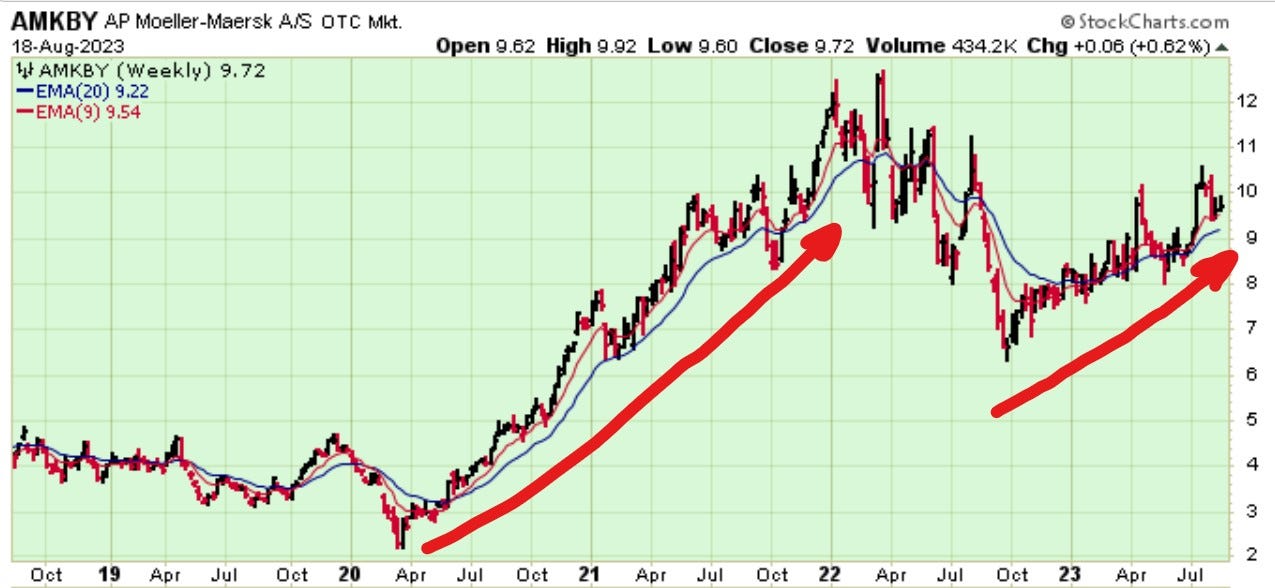
This grim outlook for global trade has not dented the enthusiasm of investors. Maersk stock is climbing nicely to higher altitudes since the October Low last year. That was when BOOM advised readers that the peak of CPI inflation was evident and the bottom was in for stock markets for most advanced nations. No other analyst made that forecast. The current uptrend in Moller appears to be strong and is a continuation of the uptrend that began in April 2020. It seems apparent that investors are looking forward to the end of the CPI inflation threat and the end of the war in Ukraine. BOOM does not like to argue with the herd. Check out the chart for the S & P 500 Stock Index in New York.
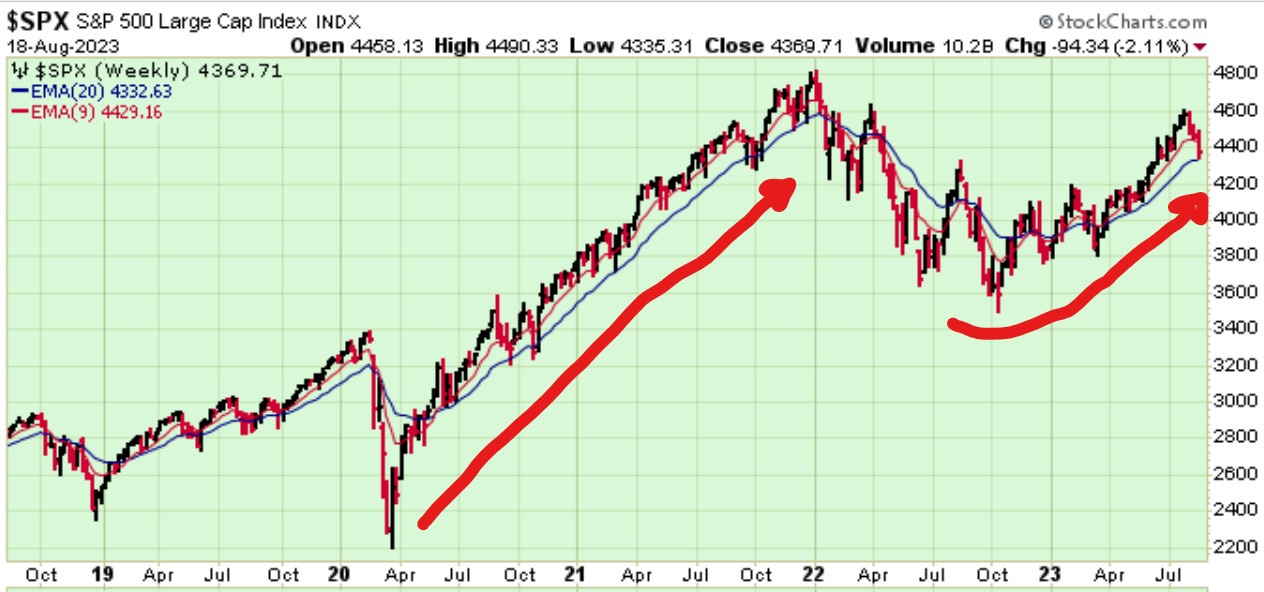
BOOM’S CHINA INDICATOR STABILISED
It is currently fashionable to predict either financial or economic crisis in China. Some forecasts predict “collapse” of either the Chinese financial markets, the real estate market or the economy itself. BOOM is mystified by these predictions. To BOOM, they appear to be some sort of narrative wish fulfilment by the mainstream media in the Western advanced economies.
BOOM’S leading economic indicator for China has stabilised and is no longer falling as it was during June and July. The conclusion is that recent claims of concern for the Chinese economy are exaggerated beyond reason. It seems as if the Western mainstream media are yet again playing “follow the leader” in creating a narrative of China weakness with little basis in fact. According to the indicator which BOOM has found very reliable in the past, the Chinese economy is certainly not rapidly expanding but neither is it contracting rapidly. And that is quite extraordinary when the lack of CPI inflation is considered.
During July, the annualised growth in Bank Loans continued at around 11.25%. That is a remarkable, constant injection of fresh new funds into the economy. And the bulk of those funds certainly don’t find their way into speculative asset trading. They are put to productive use.
China stock market indices for Shanghai and Shenzen are in consolidation patterns at present with no exuberance evident. That is no cause for dire predictions of doom.
Here is the 5 Year Chart for the Shanghai Composite Index.
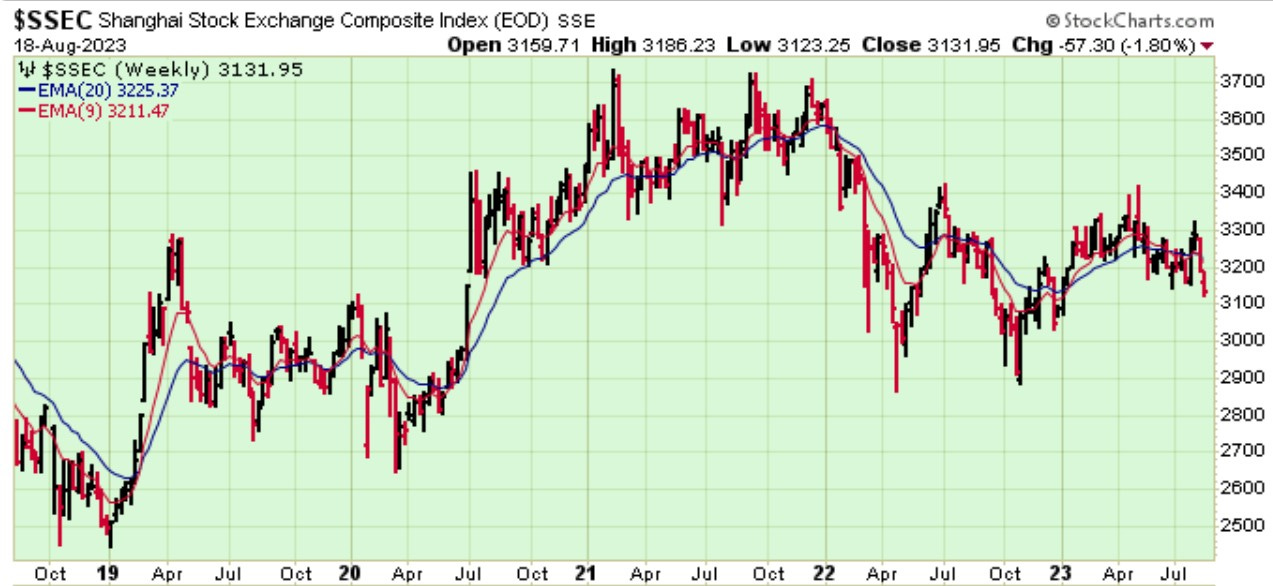
And here is the 5 Year Chart for the Dow Jones Shenzen Index
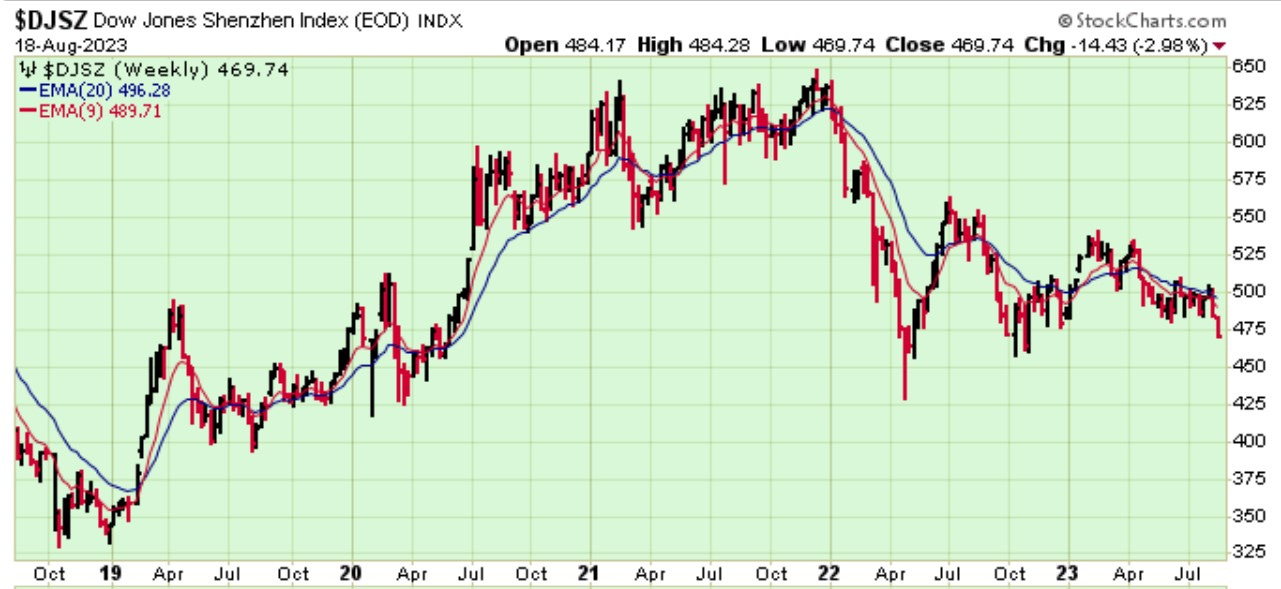
The US President, Joe Biden, recently called China a “ticking time bomb” because of its economic challenges. He pointed to China’s high unemployment and ageing workforce, saying: “China is in trouble.” More wish fulfilment. BOOM suggests that Joe should pay more attention to the US economy and leave the Chinese economy to the Chinese government.
BIG PHARMA CRIME RECORD — PFIZER FINED $ 2.3 BILLION – GLAXO SMITH KLINE FINED $ 3 BILLION
Over the last 2 years, billions of people (and their children) in many nations were coerced through extensive government and media Covid fear campaigns, government mandates and employer mandates into having a dose (or more) of immature mRNA technology injected into their arms. We now know that those Covid vaccines were not previously tested for prevention of viral transmission.
It is BOOM’s guess that almost all of the people who received Pfizer’s version of the Covid jabs were not told of Pfizer’s criminal past. And it is also BOOM’s guess that almost all of those people were not told that Pfizer’s partner in the manufacture of those products, Biontech, had never previously created any pharmaceutical product for the general public.
In other words, all of those people blindly trusted that the Pharmaceutical industry was worthy of their complete trust. And they followed the instructions of their governments to accept that the products were “safe and effective” – what ever that means. Safe for whom? How safe? Effective at what? How effective?
However, let’s look at some history. History that is easily discovered – if you look.
In 2009, Pfizer was fined US $ 2.3 Billion by the US Department of Justice for engaging in fraudulent marketing. US$ 1.2 Billion of that was a criminal fine. In other words, the company was found to have acted criminally. At the time, it was the largest health care fraud settlement in the history of the Department of Justice.
Pfizer agreed to pay the remaining $ 1 Billion of the fine to resolve allegations under the civil False Claims Act that the company illegally promoted four drugs – Bextra; Geodon, an anti-psychotic drug; Zyvox, an antibiotic; and Lyrica, an anti-epileptic drug used in pain management – and caused false claims to be submitted to government health care programs for uses that were not medically accepted indications and therefore not covered by those programs.
“The size and seriousness of this resolution, including the huge criminal fine of $1.3 billion, reflect the seriousness and scope of Pfizer’s crimes,” said Mike Loucks, acting U.S. Attorney for the District of Massachusetts. “Pfizer violated the law over an extensive time period. Furthermore, at the very same time Pfizer was in our office negotiating and resolving the allegations of criminal conduct by its then newly acquired subsidiary, Warner-Lambert, Pfizer was itself in its other operations violating those very same laws. Today’s enormous fine demonstrates that such blatant and continued disregard of the law will not be tolerated.”
But that is not the biggest fine levied in pharmaceutical history. Glaxo Smith Kline was fined US$ 3 Billion in 2012. $ 2 Billion of that fine was a civil penalty and $ 1 Billion was a fine for criminal activity. The criminal activity was for off-label promotion and failure to disclose safety data. The civil penalty was levied for paying kickbacks to physicians, making false and misleading statements concerning the safety of Avandia, reporting false best prices and underpaying rebates owed under the Medicaid Drug Rebate Program. A number of other misdemeanours involved the following products and were included in the settlement — Wellbutrin, Paxil (promotion of paediatric use), Advair, Lamictal, Zofran, Imitrex, Lotronex, Flovent, Valtrex. The US Laws violated included the False Claims Act and the Federal Food, Drug and Cosmetic Act.
In 2013, Johnson and Johnson was fined US$ 2.2 Billion for similar violations of those laws. The drug products included Risperdal, Invega and Nesiritide.
In 2012, Abbott Laboratories was fined US$ 1.5 Billion for similar violations.
A list of the 20 largest settlements reached between the United States Department of Justice and pharmaceutical companies from 2001 to 2012, can easily be found using Wikipedia if you search for the “List of largest pharmaceutical settlements”.
So, over the last 2 years, 5 Billion people, including many children, have been subject to strong governmental coercion and vigorous media campaigns to accept a drug from a drug dealer with a criminal record. Think about that.
The Pfizer fine was outlined in a Press Release from the US Department of Justice on Wednesday 2nd September 2009. It can still be found on the Department of Justice website.

In economics, things work until they don’t. Until next week, make your own conclusions, do your own research. BOOM does not offer investment advice.
Subscribe to BOOM Finance and Economics Substack
By Dr Gerry
Over 5 years on a number of platforms, BOOM has developed a loyal readership which includes many of the world’s most senior economists, central bankers, fund managers and academics.
https://boomfinanceandeconomics.substack.com/
QUANTITATIVE BOOSTING EXPLAINED
QB Explained: https://boomfinanceandeconomics.wordpress.com/2019/12/15/boom-as-at-15th-december-2019/
And BOOM’s Perfect Economy: https://boomfinanceandeconomics.wordpress.com/2020/01/18/boom-as-at-19th-january-2020/
In economics, things work until they don’t. Until next week, make your own conclusions, do your own research. BOOM does not offer investment advice.
HOW MOST MONEY IS CREATED
BANKS CREATE FRESH NEW MONEY OUT OF THIN AIR
(but they always need a Borrower to do so)
THERE IS NO SUCH THING AS A DEPOSIT
BANKS PURCHASE SECURITIES, THEY DON’T MAKE LOANS
BANKS DON’T TAKE DEPOSITS, THEY BORROW YOUR MONEY
Watch this short 15 minutes video and learn as Professor Richard Werner brilliantly explains how the banking system and financial sector really work.
How is Most New Money Created ?
LOANS CREATE DEPOSITS — that is how almost all new money is created in the economy (by commercial banks making loans).
From the Bank of England Quarterly Bulletin Q1 2014 —
“Whenever a bank makes a loan, it simultaneously creates a matching deposit in the borrower’s bank account, thereby creating new money.““Most money in the modern economy is in the form of bank deposits, which are created by commercial banks themselves”.
YouTube Video — https://www.bankofengland.co.u/quarterly-bulletin/2014/q1/money-in-the-modern-economy-an-introduction
and https://www.youtube.com/watch?v=ziTE32hiWdk
Paper: Money in the Modern Economy — CLICK HERE
Most economists are unaware of this and even ignore the banking & finance sectors in their econometric models.
On 25th April 2017, the central bank of Germany, the Bundesbank, released a statement on this matter —
“In terms of volume, the majority of the money supply is made up of book money, which is created through transactions between banks and domestic customers. Sight deposits are an example of book money: sight deposits are created when a bank settles transactions with a customer, ie it grants a credit, say, or purchases an asset and credits the corresponding amount to the customer’s bank account in return. This means that banks can create book money just by making an accounting entry: according to the Bundesbank’s economists, “this refutes a popular misconception that banks act simply as intermediaries at the time of lending – i.e. that banks can only grant credit using funds placed with them previously as deposits by other customers”. By the same token, excess central bank reserves are not a necessary precondition for a bank to grant credit (and thus create money).”
Reference: https://www.bundesbank.de/en/tasks/topics/how-money-is-created-667392
The Reserve Bank of Australia (Australia’s central bank) has also contributed to the issue in a speech by Christopher Kent, the Assistant Governor on September 19th 2018.“…… the vast bulk of broad money consists of bank deposits”“Money can be created …….. when financial intermediaries make loans““In the first instance, the process of money creation requires a willing borrower.”“It’s also worth emphasizing that the process of money creation is not the result of the actions of any single bank – rather, the banking system as a whole acts to create money.”
Disclaimer: All content is presented for educational and/or entertainment purposes only. Under no circumstances should it be mistaken for professional investment advice, nor is it at all intended to be taken as such. The commentary and other contents simply reflect the opinion of the authors alone on the current and future status of the markets and various economies. It is subject to error and change without notice.The presence of a link to a website does not indicate approval or endorsement of that web site or any services, products, or opinions that may be offered by them.
Neither the information nor any opinion expressed constitutes a solicitation to buy or sell any securities nor investments. Do NOT ever purchase any security or investment without doing your own and sufficient research. Neither BOOM Finance and Economics.com nor any of its principals or contributors are under any obligation to update or keep current the information contained herein. The principals and related parties may at times have positions in the securities or investments referred to and may make purchases or sales of these securities and investments while this site is live. The analysis contained is based on both technical and fundamental research.
Although the information contained is derived from sources which are believed to be reliable, they cannot be guaranteed.
Disclosure: We accept no advertising or compensation, and have no material connection to any products, brands, topics or companies mentioned anywhere on the site.
Fair Use Notice: This site contains copyrighted material the use of which has not always been specifically authorized by the copyright owner. We are making such material available in our efforts to advance understanding of issues of economic and social significance. We believe this constitutes a ‘fair use’ of any such copyrighted material as provided for in section 107 of the US Copyright Law. In accordance with Title 17 U.S.C. Section 107, the material on this site is distributed without profit. If you wish to use copyrighted material from this site for purposes of your own that go beyond ‘fair use’, you must obtain permission from the copyright owner.
